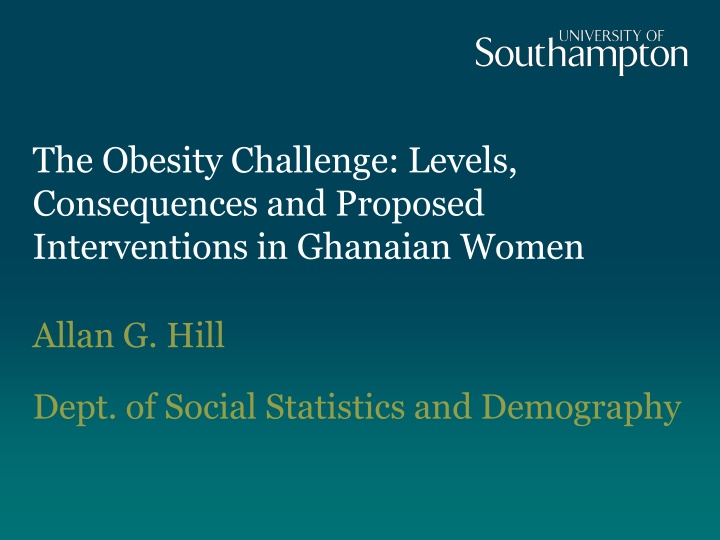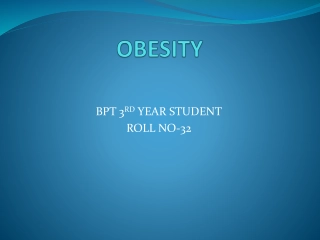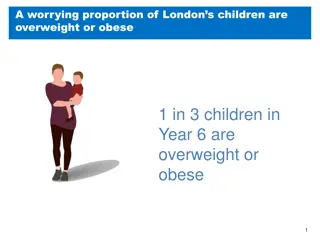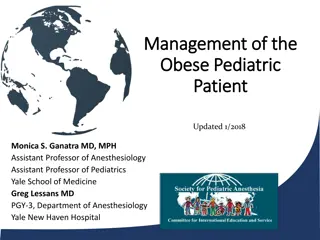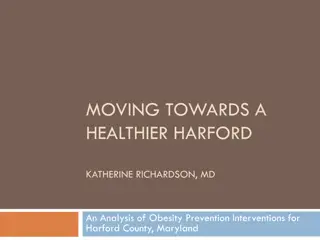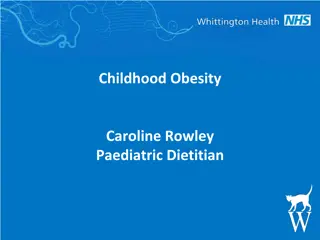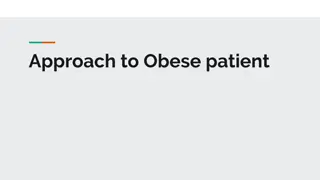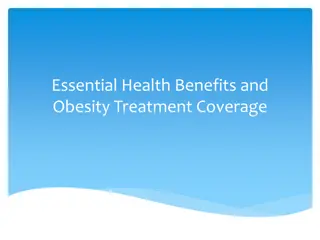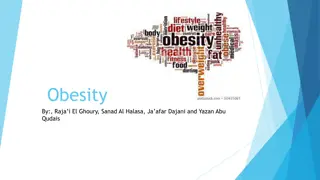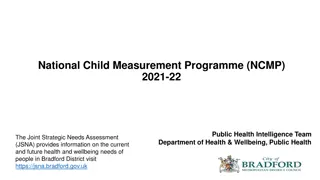Obesity Challenge in Ghanaian Women: Levels, Consequences & Interventions
The study explores obesity levels in Ghanaian women, highlighting correlations with socio-demographic factors such as age, wealth index, education, and urban/rural residence. The research indicates high rates of obesity alongside childhood under-nutrition in lower-income settings. Proposed interventions include dietary changes and increased exercise to address the obesity challenge in Accra, Ghana.
Download Presentation

Please find below an Image/Link to download the presentation.
The content on the website is provided AS IS for your information and personal use only. It may not be sold, licensed, or shared on other websites without obtaining consent from the author.If you encounter any issues during the download, it is possible that the publisher has removed the file from their server.
You are allowed to download the files provided on this website for personal or commercial use, subject to the condition that they are used lawfully. All files are the property of their respective owners.
The content on the website is provided AS IS for your information and personal use only. It may not be sold, licensed, or shared on other websites without obtaining consent from the author.
E N D
Presentation Transcript
The Obesity Challenge: Levels, Consequences and Proposed Interventions in Ghanaian Women Allan G. Hill Dept. of Social Statistics and Demography
The Broad Outlines of the Problem At much lower income levels, obesity is equally common in many African urban populations The rates of obesity are higher everywhere for women Adult obesity and childhood under-nutrition exists side by side Dietary change and increased exercise regimens are more difficult in lower income societies
Obesity levels compared: BMI >30 in adults over age 16. Japan Korea Switzerland Norway Italy Netherlands Austria Sweden France Denmark Belgium Irelande Germany Slovak Republic Portugal Finland Poland Spain Turkey Greece Canada Iceland Czech Republic Walesd Northern Irelandc Luxembourg Australia Englandb Scotlanda New Zealand Hungary Mexico United States Women in Accra, Ghana 0.00 0.05 0.10 0.15 0.20 0.25 0.30 0.35 0.40 Source: OECD Health Data 2012 - Version: October 2012
Overweight and obesity among women from Accra, Ghana by socio-demographic characteristics. Results from binomial logistic regression controlling for survey age category. Woman is obeseb (n = 973) Correlates of obesity and overweight in Accra women 2010 Woman is overweight/obesee (n = 1,702) Odds Ratioc (95% CI) Prevalence (%) 36.3 Prevalence (%) 63.40 Odds Ratio (95% CI) na 2,684 Age (years) 18-24 25-34 35-54 > 55 154 719 893 917 11.70 23.50 45.60 41.30 1.00 33.30 50.30 75.40 71.50 1.00 2.32 (1.38, 3.90) 6.33 (3.80, 10.52) 5.32 (3.20, 8.85) 2.03 (1.41, 2.93) 6.14 (4.24, 8.88) 5.01 (3.47, 7.23) Wealth Indexd Lowest Low Middle High Highest Parity 527 538 534 554 482 30.70 38.10 38.60 38.40 35.90 1.00 58.60 64.40 72.20 68.70 60.70 1.00 1.51 (1.16, 1.96) 1.48 (1.14, 1.92) 1.59 (1.23, 2.07) 1.45 (1.11, 1.91) 1.44 (1.11, 1.87) 2.02 (1.54, 2.65) 1.86 (1.43, 2.43) 1.29 (0.98, 1.68) 0 1 > 2 514 325 1839 20.40 31.70 41.60 1.00 44.40 57.70 72.00 1.00 1.32 (0.95, 1.85) 1.55 (1.18, 2.05) 1.28 (0.95, 1.72) 1.81 (1.42, 2.32) Education None Primary Middle Secondary Higher Region of Childhood 567 320 1054 441 266 36.30 38.80 34.90 35.80 36.50 1.00 66.40 64.40 64.50 62.00 65.90 1.00 1.15 (0.86, 1.54) 0.96 (0.79, 1.19) 0.93 (0.72, 1.22) 0.99 (0.73, 1.36) 0.96 (0.71, 1.30) 0.95 (0.75, 1.19) 0.77 (0.59, 1.02) 0.97 (0.70, 1.35) Benkeser, Biritwum and Hill. 2012 Ghana Med J 46(2): 66-75. Rural Urban 320 2319 36.70 32.50 1.00 64.40 64.80 1.00 1.46 (1.13, 1.88) 1.31 (1.02, 1.70) Current Marital Status Married Single 1271 1413 42.40 30.70 1.00 58.90 71.30 1.00 0.64 (0.54, 0.76) 0.62 (0.52, 0.74) a Totals may be <2,684 because of missing values. b BMI>30kg/m2 c Ratios from multivariate binomial regression model adjusted for woman's age. Estimates for all other variables were included in the model one at a time. d Wealth index created through principal components analysis of common household items and household size. e BMI > 25 kg/m2
Accra women: measured body heights and weights by age in 2010 Mean BMI distribution across 5 year age groups 35 30 Mean BMI (kg/m2) 25 20 15 10 5 0 <2425 30 35 40 45 50 55 60 65 70 75 80 85 90 95 5 Year Age Groups
BMI categories by age in Accra women in 2010. BMI categories distributed by survey age groups 100% 80% 60% Obese Overweight 40% Normal Underweight 20% 0% 18-24 25-34 35-55 > 55
Body size preferences using the Stunkard scale Stunkard Figure Rating Scale Images
Evidence on preferences: current body silhouette compared with ideal and healthiest . Current Ideal Healthiest Ideal 900 900 800 800 700 700 600 600 500 500 400 400 300 300 200 200 100 100 0 0 1 2 3 4 5 6 7 8 9 1 2 3 4 5 6 7 8 9
Not all preferences in one direction... Relationship between body satisfaction and BMI (n=2,584) BMI (kg/m2) CBI-IBIa Would like to be heavier (n=799) (%) Would like to be slimmer (n=1,100) (%) Satisfied at present (n=639) (%) <18.5 8.5 0.4 2.3 18.5-24.9 57.4 9.2 36.6 25.0-29.9 22.2 27.3 35.8 > 30.0 11.9 63.2 25.2 p <.001 a Body satisfaction calculated as current body image (CBI) minus ideal Ghanaian body image (IBI)
Intervention options Contextual interventions School meals, physical education Pricing and availability of fatty foods Urban planning and transport arrangements Community and social interventions Fitness and sport promotion: clubs Obesity as a preventable illness Individual Diet and exercise Weight watchers and the like...
Small Steps. Big Rewards. A GAME PLAN to Prevent Type 2 Diabetes Diabetes prevention and management c.f. Obesity directly GAME PLAN 50 small steps, not a single intervention (e.g. Weight Watchers) Food and activity tracker Fat and calorie counter
Scientific evidence The Diabetes Prevention Program (DPP) was a major clinical trial, or research study, aimed at discovering whether either diet and exercise or the oral diabetes drug metformin could prevent or delay the onset of type 2 diabetes in people with impaired glucose tolerance (IGT). The DPP found that over the three years of the study, diet and exercise sharply reduced the chances that a person with IGT would develop diabetes. Metformin also reduced risk, although less dramatically. The DPP resolved these questions so quickly that, on the advice of an external monitoring board, the program was halted a year early. New England J of Med February 7, 2002
10-year follow-up of diabetes incidence and weight loss in the Diabetes Prevention Program Outcomes Study During the 10 0-year (IQR 9 0 10 5) follow-up since randomisation to DPP, the original lifestyle group lost, then partly regained weight. The modest weight loss with metformin was maintained. Diabetes incidence rates during the DPP were 4 8 cases per 100 person-years (95% CI 4 1 5 7) in the intensive lifestyle intervention group, 7 8 (6 8 8 8) in the metformin group, and 11 0 (9 8 12 3) in the placebo group. Diabetes incidence rates in this follow-up study were similar between treatment groups: 5 9 per 100 person-years (5 1 6 8) for lifestyle, 4 9 (4 2 5 7) for metformin, and 5 6 (4 8 6 5) for placebo. Diabetes incidence in the 10 years since DPP randomisation was reduced by 34% (24 42) in the lifestyle group and 18% (7 28) in the metformin group compared with placebo. The Lancet, Volume 374 (9702):1677 - 1686, 14 November 2009
Study design: Phase 1 Since this is a community study and not clinic or hospital based, we shall select our participants from the population of 3200 women already enrolled in the WHSA and for whom we have prior health information. This will make the identification of those most at risk simpler. To select the at-risk women, we shall stratify the EAs by socio- economic status (variables taken from the 2000 census) in which the WHSA women live and identify 20 women in each of 6 contrasting communities defined as follows: Ethnicity language group Socio-economic status of the neighbourhood
Community strategy In each neighbourhood, identify the most active relevant civil society actors. Some may be church or mosque based groups but the investigators have already worked with associations such as the Mothers and Baby Clubs, the Nima-Mamobi-Newtown Human Rights City initiative and have been supported by city councillors known as Assemblymen and Women who are elected to the Accra Metropolitan Area Council. Focus groups to obtain general reactions to the Power to Prevent approach and then after adaptation, translate the materials into the three main languages
Key qualitative research More information about food groups, food intake, portion sizes and ingredients (already begun). From exhaustive list of Small Steps, agree on the (less than 50!) that would form the menu offered to community groups of women. Develop diaries with language accessible to women from different language groups
Enrollment and follow-up Women enrolled and held in the program for 3 months. Record which behaviours are most readily adopted and record blood pressure, weights, heart rate, and waist and hip measurements for all the participating women. At the end of 3 months, new focus groups to gather the women s reactions to the interventions. The Ghana School of Public Health to convene a meeting of stakeholders (Ghana Health Services and the leading NGOs able to take on the program themselves) and make recommendations for next steps. Basis for full-scale trial of the approach to a much larger set of at-risk women.
Examples of the 50 or so steps used in the US trials Reduce Portion Sizes Put less on your plate, Nate. 1. Drink a large glass of water 10 minutes before your meal so you feel less hungry. 2. Keep meat, chicken, turkey, and fish portions to about 3 ounces. Eat a small meal, Lucille. 4. Use teaspoons, salad forks, or child-size forks, spoons, and knives to help you take smaller bites and eat less. 5. Make less food look like more by serving your meal on a salad or breakfast plate. How much should I eat? Try filling your plate like this: 1/4 protein 1/4 grains 1/2 vegetables and fruit dairy (low-fat or skim milk)
Move More Each Day Find ways to be more active each day. Try to be active for at least 30 minutes, 5 days a week. Walking is a great way to get started and you can do it almost anywhere at any time. Bike riding, swimming, and dancing are also good ways to move more. Dance it away, Faye. 8. Show your kids the dances you used to do when you were their age. Let's go, Flo. 11. Deliver a message in person to a co-worker instead of sending an e-mail. 12. Take the stairs to your office. Or take the stairs as far as you can, and then take the elevator the rest of the way.
Choose to eat more vegetables, fruits, and whole grains. Cut back on high-fat foods like whole milk, cheeses, and fried foods. This will help you reduce the amount of fat and calories you take in each day. Snack on a veggie, Reggie. 17. Buy a mix of vegetables when you go food shopping. 18. Choose veggie toppings like spinach, broccoli, and peppers for your pizza. Cook with care, Claire. 22. Stir fry, broil, or bake with non-stick spray or low-salt broth. Cook with less oil and butter. Cook in style, Kyle. 25. Cook with a mix of spices instead of salt. 26. Try different recipes for baking or broiling meat, chicken, and fish. Eat healthy on the go, Jo. 29. Have a big vegetable salad with low-calorie salad dressing when eating out. Share your main dish with a friend or have the other half wrapped to go.
Drinking and snacking Rethink your drink, Linc. 33. Find a water bottle you really like (from a church or club event, favourite sports team, etc.) and drink water from it every day. Eat smart, Bart. 37. Eat foods made from whole grains every day, such as whole wheat bread, brown rice, oats, and whole grain corn. 42. Eat a healthy snack or meal before shopping for food. Do not shop on an empty stomach. Keep track, Jack. 44. Make a list of food you need to buy before you go to the store. Read the label, Mabel. 46. Compare food labels on packages.
Risks and expectations Moving more in near-equatorial Africa is hot and uncomfortable... The urban environment is polluted and pavements are rough and dangerous with little green open space except the beach Portion control is difficult when cooking and eating is a collective activity BUT social cohesion is strong and obesity is now part of the national debate
Signs of public engagement: Accra, March 22, 2014 GNA Ghana has the largest number of overweight and obese people of over three million out of the estimated population of 20 million, statistics on the prevalence of overweight and obesity in seven African countries have shown. The countries are Ghana, Congo Brazzaville, Liberia, Nigeria, Niger, Senegal and Sierra Leone. Health Minister Major Courage Quashigah (Rtd) made this known in a speech read on his behalf at a health Symposium on the Prevalence of Obesity in Ghana in Accra on Thursday. Overweight and obesity, which were considered problems only in high - income countries, were dramatically on the rise in low and middle- income countries particularly in urban settings, the minister noted.
